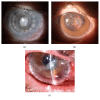Differences in Surgical Management of Corneal Perforations, Measured over Six Years
- PMID: 28326192
- PMCID: PMC5343566
- DOI: 10.1155/2017/1582532
Differences in Surgical Management of Corneal Perforations, Measured over Six Years
Abstract
Purpose. To report the surgical approach, anatomical and functional results, and complications in the group of patients with corneal perforation. Materials and Methods. 247 eyes with corneal perforation were operated on between January 2010 and July 2016. The three surgical procedures, dependent on size and location of perforation, were performed: full-sized penetrating keratoplasty, corneoscleral patch graft, and anterior lamellar keratoplasty. The eyes underwent the minimum 6-month follow-up visit. Results. Between January 2010 and July 2016, 247 surgeries were performed: 116 penetrating keratoplasties, 117 corneoscleral patch grafts, and 14 anterior lamellar keratoplasties. More than one procedure was necessary in 32 eyes. Final improvement of the visual acuity, within a gain of 2 or more lines with the Snellen test, was achieved in 56 operated eyes. To achieve better final visual acuity, 75 eyes required successive surgical treatment. Complications of the surgery comprised persistent epithelial defect, glaucoma or ocular hypertension, corneal oedema, graft melting, loose corneal sutures, reinfection, anterior synechiae and fibrinoid membranes, and endophthalmitis. In 26 eyes, the treatment failure was reported. Conclusions. There is no one general-purpose surgical technique to treat corneal perforations. The complex nature of this pathology remains the individual, careful but also very distinct and multifactorial approach.
Conflict of interest statement
The authors declare that there is no conflict of interest regarding the publication of this paper.
Figures
References
-
- Loya-Garcia D., Serna-Ojeda J. C., Pedro-Aguilar L., Jimenez-Corona A., Olivo-Payne A., Graue-Hernandez E. O. Non-traumatic corneal perforations: aetiology, treatment and outcomes. The British Journal of Ophthalmology, Electronic Publication. 2016 doi: 10.1136/bjophthalmol-2016-308618. - DOI - PubMed
LinkOut - more resources
Full Text Sources
Other Literature Sources


